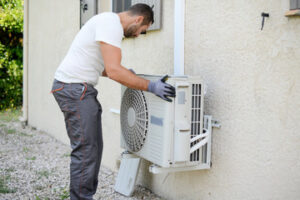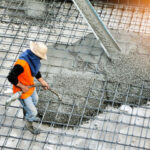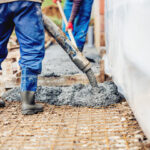Home » HVAC
Category Archives: HVAC
How Your HVAC System Heats and Cools Your Home
The hvac that heats and cools your home works by moving air from the outside into your house. A blower, an air filter and ductwork help facilitate this movement.

A home’s HVAC system also helps remove moisture, smoke, dust, bacteria, odors and carbon dioxide from conditioned air that circulates throughout the house. Contact Ausco Air Heating & Air Conditioning for professional help.
Heat pumps are all about transferring renewable energy from the air, ground or water and delivering it to your home as heating and cooling. The basic process is similar to the one used by refrigerators: Liquid refrigerant in a coil absorbs heat from the air (even at freezing temperatures), and electricity powers a compressor that squeezes the liquid, making it really hot. This heat is then pumped into a second coil, where it’s heated by a fan blowing over it, and a warm air stream is pushed into the home. The refrigerant then cools back to a liquid, and the cycle repeats.
In winter, heat pumps run in reverse, absorbing the heat energy from the air outside your home (even at subfreezing temperatures) and transferring it inside. This process can cut your energy use for heating by up to 50% compared to electric resistance systems like baseboard heaters or furnaces.
There are several different types of heat pump, including ductless options that offer easier installation in homes with no existing ductwork. Ductless heat pumps also allow you to control the temperature in each room of the house with individual head units. Regardless of the type of heat pump you choose, it’s important to have your system regularly maintained by an MSC heating engineer.
As a rule of thumb, we recommend having your heat pump serviced in the summer, just as you’d have your air conditioner serviced. This will ensure that the refrigerant is in a safe and working condition and ready to perform its best when it’s time to heat your home.
As the world moves toward lower-carbon energy sources, heat pumps are becoming increasingly popular, especially in colder climates. They’ve been shown to shrink carbon emissions from space heating — even when they run on electricity that is produced partly by fossil fuels. As a result, many homeowners are saving hundreds of dollars every year by switching to heat pumps. And they’re even eligible for big government rebates! To find out if a heat pump is right for you, schedule an appointment with your local Trane comfort specialist. They’ll be familiar with the climate in your area and your home’s layout, insulation and other factors to recommend a customized solution based on your specific needs.
Furnaces
Furnaces warm air, and a blower fan sends it to ductwork for distribution throughout your home. They can be powered by electricity, natural gas, oil or propane. Furnaces are one of the oldest types of heating systems still in use today. There are many different kinds of furnaces, all with unique characteristics, costs and efficiency ratings. Some are single-stage, others are two-stage, and some operate at variable speed. The kind you choose depends on a few factors.
First, consider what your specific indoor comfort needs are. Do you have humidity problems? Do you have hot or cold spots in your house? Then think about your budget. A new furnace can be expensive, so it’s important to understand the costs involved before making any decisions.
Most of us know that our furnaces create heat and distribute it via ductwork and vents, but how do they actually work? Understanding the process can help you troubleshoot problems and even prevent costly emergency services calls or furnace replacement.
In a standard, single-stage gas furnace, the burner ignites the gas and heats it up to the temperature set by the thermostat. The heat rises up through the combustion chamber and into the heat exchanger where it’s transferred to the incoming air, warming it. When the thermostat senses the room temperature has reached the desired temperature, it turns off the burner and shuts off the gas valve.
To avoid overheating, the heat exchanger has a flame detector that signals when it’s too hot and opens the gas valve to shut off the flow of fuel. The system also has a blower fan and a plenum that carries return and supply air. The blower draws the cooler air from return vents, blows it past the heat exchanger and forces warmed air into the home’s ducting.
If the heat exchanger cracks, carbon monoxide leaks into the ducting and circulates in your home, causing health issues and possibly death. To prevent this, it’s important to regularly replace the air filter and use a more airflow-friendly (higher MPR) vent cover and duct tape. You can also reduce blockages by ensuring the return and supply vents are open, using a high-efficiency blower, reducing the load on the system with smaller rooms and adding insulation to the ductwork.
Air Conditioners
Air conditioning systems work by cooling the air inside your home or business using a coil filled with a refrigerant. They then blow that cool air through a system of ducts in the walls and floors. If the cooling system becomes too warm, it will reject that heat to the outside air through a big fan in the outdoor unit. That air also has the benefit of absorbing the sun’s rays, causing them to lose their heating potential.
In 1933, Willis Carrier developed a belt-driven compressor, blower and mechanical controls that would become the standard in modern cooling technology. While today’s air conditioners operate on the same basic principles as Carrier’s design, they have improved significantly in terms of vapor compression and refrigeration cycle efficiency.
Today’s AC units typically run on either electricity or gas. Gas units operate differently than electric ones, but they offer an effective and efficient alternative to traditional oil furnaces. Most homeowners choose to combine their air conditioning setup with a gas furnace for complete HVAC solutions.
Unlike smaller room air conditioners that plug into household outlets, larger systems require their own dedicated 115-volt electrical circuits to function properly. This allows them to operate without the risk of tripping the home’s main circuit breakers. In fact, some models even offer a built-in thermostat to help regulate energy consumption.
The most popular type of AC is a central AC system. These are made up of two components, a large metal cabinet outside the house that houses the compressor and condenser, and an indoor unit that contains the evaporator coil. This unit can be split into multiple units that are linked by pipes, or it can be a single package system that includes all of the equipment in one cabinet. Those with only one indoor unit are known as “mono-split” systems, while those with several indoor units are called “multi-split.”
During an Air Conditioning, Heating and Refrigeration Technology program at the ACC Career Center, students have hands on experience working on all of these different types of equipment. This gives them the knowledge and confidence to diagnose problems and perform repair services.
Ductwork
Ductwork is the system of air vents that deliver heated or cooled air to your home’s living spaces. This hidden network is an integral part of your HVAC system, regulating indoor temperatures and reducing energy bills by improving airflow. Poorly designed or maintained ductwork can create problems that lead to low indoor air quality, higher energy bills, and inefficient HVAC systems.
When it comes to ducting, there are various factors that determine how well your system works. For example, if your ducts are the wrong size, they may restrict airflow and cause your heater or air conditioner to work harder than it should. Fortunately, this is easy to fix. The solution involves having your ducts professionally sized by an HVAC technician. The HVAC technician will take various measurements, including square footage of your home, square footage of each room, cubic feet per minute, and friction loss.
In addition, the HVAC technician will look for a proper duct connection. There are several types of duct connections, such as slip joints, couplings, and flange connections. In the case of flange connections, a duct may be crimped and sealed with mastic sealant or HVAC metal tape to ensure that there are no leaks. Ideally, all connections are also made with duct insulation to prevent moisture issues, air leaking, and to reduce your heating or cooling costs.
The HVAC technician will also inspect and clean your ducts. For mildly dirty ducts, he or she may use a rotating brush to remove dust, debris, and other contaminants from the inside of your ductwork. For heavily clogged or dirty ducts, a power vacuum will be used. This involves inserting a large vacuum line into your ducts and pulling air out of them to clean the entire system.
In order to properly maintain your ductwork, you should survey it periodically for cracks and holes. These can cause a major increase in static pressure, which can make your blower fan work harder than it should. In addition, you should have your ducts cleaned at least every five years. This will prevent a build-up of allergens like pollen and dust that can negatively affect your health.




